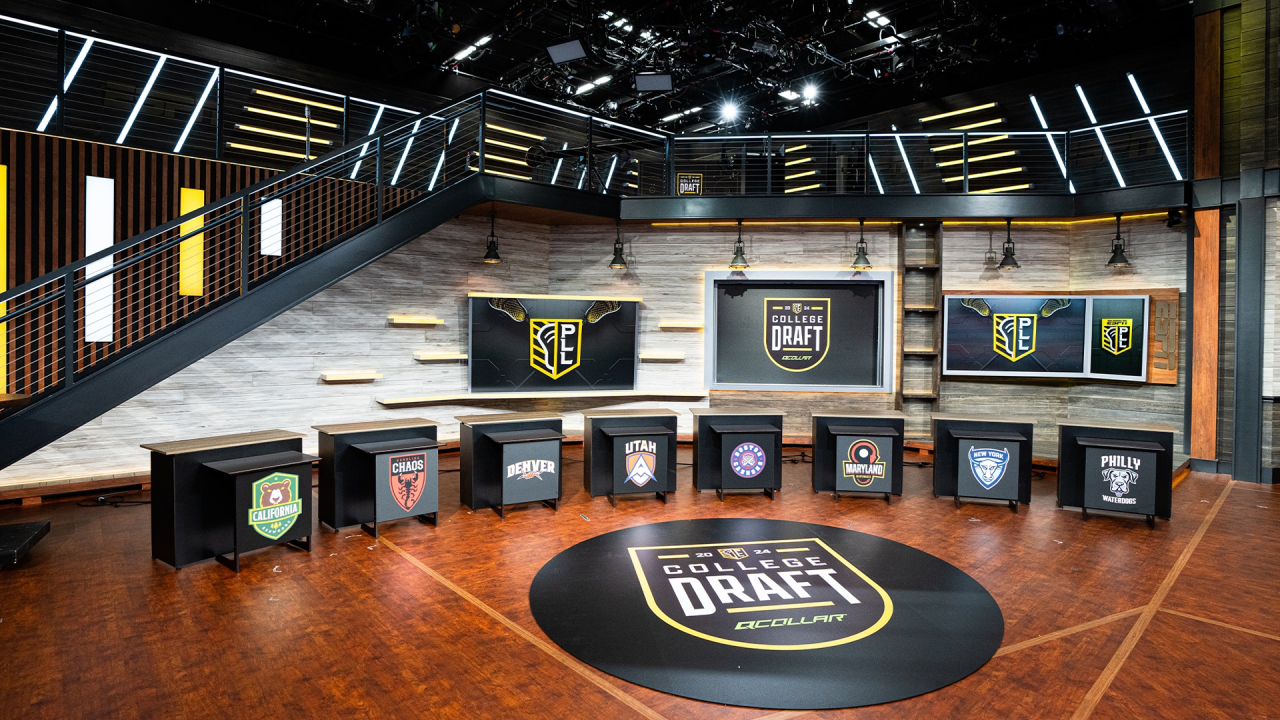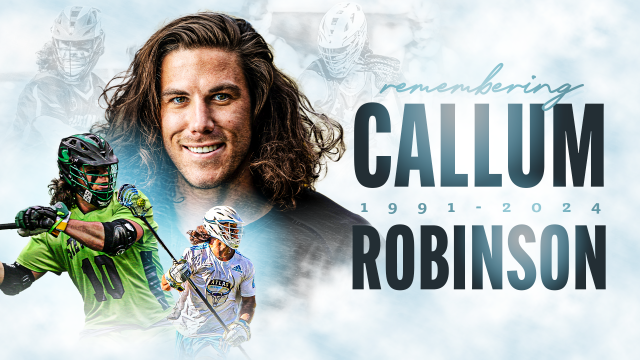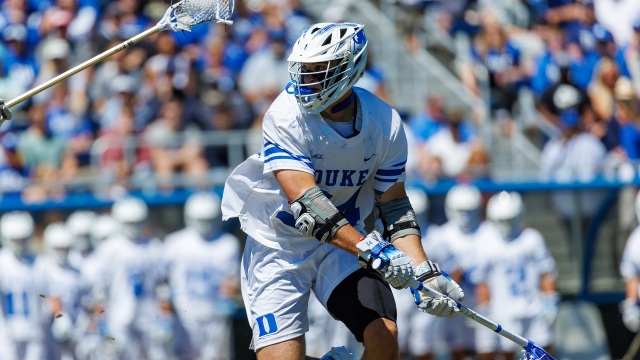03:00 PM
May 24


03:00 PM
May 24


05:30 PM
May 24


-
May 25


-
May 25


© 2024 USA Lacrosse. All Rights Reserved.

BRISTOL, Conn. — The first pro field lacrosse draft was held in 2001, ahead of the inaugural season of Major League Lacrosse. In the years since, the draft has moved around a bit.
It’s been held in hotels in Philadelphia and Baltimore. It’s been held on college campuses like Sacred Heart, Stony Brook and Yale. It’s been at the Haverford School in Pennsylvania. In 2008, the year Paul Rabil was taken first overall, the draft was held at Stevens Institute of Technology in Hoboken, NJ.
It’s been virtual, it’s been at the NASCAR Hall of Fame, it’s been at the Baltimore Convention Center, USA Lacrosse Headquarters, and even Toby Keith’s Bar and Grill. Over the past five years, the Premier Lacrosse League has aimed to elevate the event. And now, the long and winding road for the draft may finally have a long-term home: ESPN Headquarters.
Once an event that was done ahead of time, and then broadcasted or streamed separately, the PLL College Draft is a live production. Tuesday night’s draft was the end of a year’s worth of anticipation. The moment the 2023 draft ended, fans and pundits alike began to look toward a 2024 draft class that would feature Brennan O’Neill, Connor Shellenberger and Pat Kavanagh. Billed by the league as “The Greatest Draft”, the buildup created an opportunity. It was a chance to have the draft itself become a marquee event that matched the prodigious talent of the players being selected.
Tuesday was a whirlwind. The PLL crew arrives days in advance. The draft aired at 7 p.m. EDT on ESPNU and ESPN+, but draft day itself begins much earlier. Coaches arrive before noon, met by the PLL’s media team, which shares the arrivals on social media.
Press conferences began at noon, with each coach spending 30 minutes in front of the camera and media members hurling questions their way both virtually and in person. Questions are aimed to try and draw out any hints of draft strategy — targeted players, scenarios they’re planning for, trade talks — or any morsel that might be let slip.
The back and forth yielded a few nuggets. New York Atlas head coach Mike Pressler said he and his staff were anticipating O'Neill to go first, even as public speculation swirled about which of the “Big Three” could be the first off the board. Maryland Whipsnakes head coach Jim Stagnitta talked about having needs on the defensive end and drafting for needs in a class without a lot of defensive depth — a signal he might pass on one of the Big Three with the No. 3 pick.
Carolina Chaos head coach Andy Towers spoke about offensive philosophical changes, which suggested that while in the past he might have valued a player with a box background, it wasn’t quite as much a priority anymore. And of course, Denver Outlaws head coach Tim Soudan gave no indication as to which way he was leaning with that team-altering first selection.
After a half-hour of prodding from the media, coaches were ushered to another production room on the massive ESPN campus for the filming of features. They spoke further about the draft, the remarkable talent and their thought processes on building their teams.
Media meetings, features, draft prep, it all continued for several hours through the afternoon, leading — at long last — to the start of the actual event. There is a longstanding trope that TV studios are much smaller in person than they appear to a viewer at home. This studio may have been the exception. It was bigger than some of the apartments I’ve lived in.
Upon entering the studio, the path forks right and left. To the left, a massive trio of connected screens, standing roughly 15 feet high. The draft order appeared across the screens, with team names ready to be replaced by the players selected. Across from the screen were eight desks, one for each of the coaches, marked with their club’s new logos for the upcoming season; the first with teams assigned to home markets.
THE FINAL 2024 COLLEGE DRAFT BIG BOARD 📊👏
What a night, @espn! pic.twitter.com/ulkHg833WW— Premier Lacrosse League (@PremierLacrosse) May 8, 2024
Coaches sit close enough together to speak to each other. That’s important, because during media availability, coaches said they were looking for moments when the camera isn’t on them, so they can lean over or go engage others in trade talks. Behind the desks is a staircase up to a small balcony that overlooks this portion of the studio. A podium stands with more lighting and cameras; this is where the picks will be announced.
On the right side of the studio, a large three-person desk that’s familiar to anyone who’s seen an ESPN studio show in the last 15 years. It’s branded for the PLL College Draft. This is where host Chris Cotter and analysts Paul Carcaterra and Ryan Boyle sit, breaking down each pick as it happens.
Behind the cameras pointed at the desk is a seating area with eight (very comfortable looking) chairs. At first, it was a bit of a mystery as to who these might be for. But it became clear later. The PLL held a contest, asking fans of each of the eight clubs to submit videos of themselves explaining why they are the biggest fan of their team. From the submissions, a winner was chosen for each club, and that winner was flown to Bristol. Each pick in round four was announced by the selecting team’s “super fan.”
The Outlaws wasted no time when the draft began. Paul Rabil ascended the studio staircase, walked to the well-lit podium and announced that O’Neill was the pick. Shellenberger followed, and things were going to script. As he hinted earlier in the day, Stagnitta chose a defender, Ajax Zappitello, which began the shuffling of draft boards. Kavanagh, the presumed No. 3 pick, slid all the way to the sixth pick. He was taken by the Boston Cannons, uniting him with his older brother, Matt. Head coach Brian Holman was asked earlier in the day about the possibility of getting Pat and said he didn’t want to tip his hand, but it would be a fair assumption that if Pat was available, he’d take him.
The draft was full of intrigue. Pressler made a trade prior to the draft to acquire the fifth overall pick, which he used on Notre Dame netminder Liam Entenmann. Skeptics wondered if the pick was too high, and if Entenmann may still have been available at No. 10, where the Atlas picked again. Afterward, the questions were answered. Soudan, who picked ninth, said that if Entenmann had made it to No. 9, they would have had a very difficult time passing on him. Pressler was standing nearby, and smiled when he heard his strategy had paid off. Pressler secured the draft’s top goalie and was able to secure Swiss Army knife Jake Stevens at No. 10.
The slide of the draft was not Kavanagh, but TJ Malone. Carcaterra had a first-round grade for Malone, and other analysts held Malone in similar regard. The expectation was that the Penn State speedster and QB would not last through the first two rounds, but picks kept going by, and he wasn’t taken. The Whipsnakes were the beneficiaries, selecting Malone with the first pick in the thrid round. Stagnitta, who didn’t have a second-round pick, said that as it was happening, it was hard to believe that Malone might actually make it all the way to him. He was very happy he did.
In the NFL, the last pick in the draft is nicknamed “Mr. Irrelevant.” The last pick in this draft is anything but. The California Redwoods acquired the last pick from the Archers for a future third-round pick and used it on Virginia defenseman Cole Kastner. Kastner is spending next year playing basketball at Stanford, so the pick, at the moment, was read as a major risk by the Redwoods. If Kastner decided to pursue basketball beyond next year, it would be a pick wasted and a future pick lost to boot. Redwoods head coach Nat St Laurent was coy about the pick, but said he had a good reason to take Kastner and that fans would find out more soon.
Coaches met with the media again after the draft to talk through surprises and their initial reactions. All were pleased with their returns. They all noted the remarkable depth and pointed to the post-draft waiver process as something to watch. Players not selected can still be added to rosters, which expand to 30 players for training camp. Multiple coaches said they had players on their draft boards they loved, and those players ended up undrafted. The chess match to claim players in the correct order so that priority delivers the names that coaches want most was on immediately.
A day that began nearly 12 hours earlier had wrapped. Crews began breaking down the sizable studio. Coaches made their way home from Bristol.
The following day, Kavanagh appeared on the Pat McAfee Show on ESPN to talk about being drafted and joining his brother on the Cannons. Rabil appeared on “Closing Bell” on CNBC, where he talked about how far pro lacrosse has come.
For the draft in particular, how far indeed.
Dan Arestia grew up playing lacrosse in New Canaan, Conn. He coached youth lacrosse in New Canaan, Darien and Westport and spent seven years coaching at Darien (Conn.) High School. In his time on the sidelines, he coached multiple All-Americans and Connecticut Players of the Year. His coverage of high school, college and professional lacrosse has appeared in Inside Lacrosse, New England Lacrosse Journal, and Prep Network, and he has been quoted in The Ringer and The Wall Street Journal. He also hosts the Sticks In Lacrosse podcast. He has covered Division II and III men's lacrosse and written features for USA Lacrosse Magazine since 2023.




